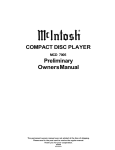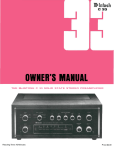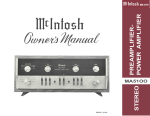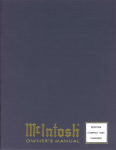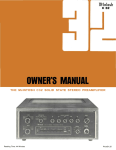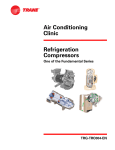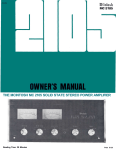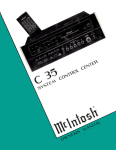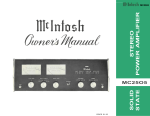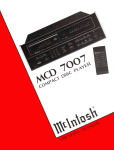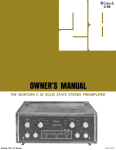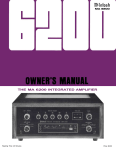Download THE MclNTOSH MC 502 POWER AMPLIFIER
Transcript
THE MclNTOSH MC 502 POWER AMPLIFIER Reading Time: 28 Minutes Price $2.00 VARIOUS REGULATORY AGENCIES REQUIRE THAT WE BRING THE FOLLOWING INFORMATION TO YOUR ATTENTION. PLEASE READ IT CAREFULLY. WARNING: TO PREVENT FIRE OR SHOCK HAZARD, DO NOT EXPOSE THIS UNIT TO RAIN OR MOISTURE. The Mclntosh you have purchased is a Model MC 502. It has a serial number located on the rear panel of the chassis. Record that serial number here: Serial Number The model, serial number and purchase date are important to you for any future service. Record the purchase date here: Purchase Date Upon application, Mclntosh Laboratory provides a Three-Year Service Contract. Your Mclntosh authorized Service Agency can expedite repairs when you provide the Service Contract with the instrument for repair. To assist, record your Service Contract number here: Service Contract Number Your MC 502 Stereo Power Amplifier will give you many years of pleasant and satisfactory performance. If you have any questions, please contact: Contents CUSTOMER SERVICE Mclntosh Laboratory Inc. 2 Chambers Street Binghamton, New York 13903 Phone: 607-723-3512 HOW TO INSTALL... 2,3 HOW TO CONNECT... 4 THE FRONT PANEL CONTROLS AND HOW TO USE THEM... 7 REAR PANEL INFORMATION... 8 PERFORMANCE LIMITS... 9 PERFORMANCE CHARTS ...10,11 TECHNICAL DESCRIPTION ...12,13 BLOCK DIAGRAM...14 Take Advantage of 3 years of Contract Service ... Fill in the Application NOW. MclNTOSH THREE YEAR SERVICE CONTRACT An application for A THREE YEAR SERVICE The terms of the contract are: 1. Mclntosh will provide all parts, materials and labor needed to return the measured performance of the instrument to the original performance limits. The SERVICE CONTRACT does not cover any shipping costs to and from the authorized service agency or the factory. 2. Any Mclntosh authorized service agency will repair Mclntosh instruments at normal service rates. To receive service under the terms of the SERVICE CONTRACT, the SERVICE CONTRACT CERTIFICATE must be presented when the instrument is taken to the service agency. 3. A l w a y s have service done by a Mclntosh authorized service agency. If the instrument is modified or damaged as a result of unauthorized repair, the SERVICE CONTRACT will be cancelled. Damage by improper use or mishandling is not covered by the SERVICE CONTRACT. 4. The SERVICE CONTRACT is issued to you as the original purchaser. To protect you from misrepresentation, this Copyright 1979 © by Mclntosh Laboratory Inc. 1 CONTRACT is included with this manual. 5. 6. 7. 8. contract cannot be transferred to a second owner. To receive the SERVICE CONTRACT, your purchase must be made from a Mclntosh franchised dealer. Your completely filled in application for the SERVICE CONTRACT must be postmarked within 30 days of the date of purchase of the instrument. To receive the SERVICE CONTRACT, all information on the application must be filled in. The SERVICE CONTRACT will be issued when the completely filled in application is received by Mclntosh Laboratory Incorporated in Binghamton, New York. Units in operation outside the United States and Canada are not covered by the Mclntosh Factory Service Contract, irrespective of the place of purchase. Nor are units acquired outside the U.S.A. and Canada, the purchasers of which should consult with their dealer to ascertain what, if any, service contract or warranty may be available locally. The recommended minimum space for installation is 15 inches (38.1 cm) deep, 17 inches (43.2 cm) wide, and 4-1/2 inches (11.4 cm) high. To install the instrument in a Mclntosh cabinet, follow the instructions that are enclosed with the cabinet. For any other type of installation follow these instructions: 1. Open the carton and remove the PANLOC brackets, hardware package, and mounting template from the carton. Remove the MC 502 from its plastic bag and place it upside down on the shipping pallet; unscrew the four plastic feet from the bottom of the chassis. 2. Mark the cabinet panel. Place the mounting template in the position on the cabinet panel where the instrument is to be installed, and tape it in place. The broken lines that represent the outline of the rectangular cutout also represent the outside dimensions of the chassis. Make sure these lines clear shelves, partitions, or any equipment. With the template in place, first mark the six A and B holes and the four small holes that locate the corners of the cutout. Then, join the four corner markings with pencil lines, using the edge of the template as a straightedge. 3. Drill Holes Use a drill with a 3/16 inch bit held perpendicular to the panel and drill the six A and B holes. Then, using a drill bit slightly wider than the tip of your saw blade, drill one hole at each of two diagonally opposite corners. The holes should barely touch the inside edge of the penciled outline. Before taking the next step, make sure that the six A and B holes have been drilled. 4. Saw the Panel Cutout Saw carefully on the inside of the penciled lines. First make the two long cuts and then the two short cuts. After the rectangular opening has been cut out, use a f i l e to square the corners and smooth any irregularities in the cut edges. The PANLOC system of installing equipment conveniently and securely is a product of Mclntosh research. By depressing the two PANLOC buttons on the front panel, the instrument slide can be locked firmly in place or it can be unlocked so that the chassis can slide forward, giving you easy access to the top and rear panels. The trouble-free life of an electronic instrument is greatly extended by providing sufficient ventilation to prevent the buildup of high internal temperatures that cause deterioration. Allow enough clearance so that cool air can enter at the bottom of the cabinet and be vented from the top. With adequate ventilation the instrument can be mounted in any position. 2 5. Install the Mounting Strips In the hardware package you will find two mounting strips, and two sets of machine screws. For panels that are less than 1/2 inch thick, use the 3/4 inch screws; for panels that are more than 1/2 inch thick, use the 1-1/4 inch screws. Starting at the right-hand side of the panel, insert a screw of the proper length into the center hole in the panel, marked B on the templete. On the back of the panel, align a mounting strip with the holes in the panel and tighten the screw until the screwhead is pulled into the wood. Repeat this procedure to attach the mounting strip to the left side of the panel. 6. Attach the PANLOC Brackets Using two screws of the proper length in the A holes on each side, attach the PANLOC brackets to the cabinet panel; the short flange is mounted against the front (face) of the cabinet panel. The screws pass through the PANLOC bracket flange, the cabinet panel, and then through the mounting strips previously mounted. 7. Install the Instrument Guide the AC power cord through the panel opening to the back of the cabinet; then, slide the instrument into the opening carefully so that the rails on the bottom of each side of the chassis engage the tracks on the mounting brackets. Continue to slide the instrument into the cabinet until it is stopped by the adjust position latches. Press the latches inward, this permits the instrument to slide into the cabinet until its front panel is flush with the cabinet panel. Depress the PANLOC buttons at the lower left and right corners of the instrument panel to lock the unit firmly in the cabinet. Depressing the PANLOC buttons again will unlock the instrument so that it can slide forward to the adjust position; if you press inward on the adjust position latches then you can remove the instrument from the cabinet. 3 How to Connect INPUT STEREO OR TWIN AMPLIFIER OPERATION Use shielded cables to connect the signal from the preamplifier or signal source to the power amplifier input. To minimize the possibility of hum the shielded cables should be run parallel to each other or loosely twisted together. Locate the cables away from speaker leads and AC power cords. All connections are made on the back panel of the MC 502. Wire Gauge For stereo operation, the left output of the preamplifier should be plugged into the Left input jack of the power amplifier. The right output of the preamplifier should be plugged into the Right (MONO) input jack of the power amplifier. 22 20 18 16 14 12 10 MONOPHONIC OR SINGLE CHANNEL OPERATION A shielded cable from the signal source is plugged into the Right (MONO) input jack of the MC 502 only. The MODE SWITCH on the back panel of the amplifier must be placed in the MONO position. In the MONO position the right channel input jack connects to both amplifiers. The Left INPUT is disconnected. MAXIMUM WIRE LENGTHS For 8 Ohm Load For 4 Ohm Load Meters Feet Meters Feet 6 10 15 3.1 4.6 25 7.6 40 60 100 12.2 18.3 30.5 1.8 12 20 30 50 80 120 200 3.7 6.1 9.1 15.2 24.4 36.6 66.0 Wire lengths above represent the wire resistance equal to 5% of the speaker impedance. For multiple speaker operation, run separate leads from the amplifier to the speakers. CONNECTING LOUDSPEAKERS FOR STEREO Connect the leads from the left loudspeaker to the Left and Common OUTPUT terminals on the MC 502. Connect the leads from the right main loudspeaker to the Right and Common terminals. CONNECTING ONE LOUDSPEAKER FOR MONO Connect leads from the loudspeaker to the Left and Right OUTPUT terminals on the MC 502. Check to be sure the MODE switch is in the MONO position. In MONO operation neither output terminal (Left or Right) is at ground potential. The output is balanced to ground. Due precaution is required when connecting test instruments since neither terminal can be grounded. OUTPUT Selection of the proper gauge wire to connect the loudspeakers preserves the quality of sound reproduction for which the loudspeakers have been designed. If undersize wire is used, resistance is added to the amplifier/loudspeaker combination which adversely affects the performance. Added resistance causes reduction of damping characteristics, modification of frequency response and reduction in power output. Use lamp cord, bell wire, or wire with similar type of insulation to connect the speakers to the amplifier. In all cases, the leads to and from the speaker should be twin conductor or twisted together. When using 8 ohm speakers and for the normally short distances of under 30 feet between the amplifier and speaker, No. 18 wire or larger can be used. For distances over 30 feet between the amplifier and speaker use larger diameter wire. Select the correct size wire for the wire length from the chart. It is recommended that the DC resistance of the speaker leads be less than 5% of the speaker impedance. Up to 10% can be tolerated. Resistance of the leads should be computed for the length of wire both to and from the speaker or speakers. AC POWER The amplifier AC power cord is plugged into a 120 volt 50/60 Hz wall outlet. FUSE A 4-amp fuse protects the MC 502 circuits. The fuse does not protect additional equipment connected to the rear panel AC power outlets. 4 LEFT SPEAKER RIGHT SPEAKER Stereophonic Connections MONO STEREO MODE PROGRAM SOURCE PLACE SWITCH IN STEREO POSITION FOR STEREO OPERATION Monophonic Connections SPEAKER MONO STEREO MODE PLACE SWITCH IN STEREO POSITION FOR STEREO OPERATION PROGRAM SOURCE Front Panel Controls and How to Use Them LEFT GAIN Use the left gain control to adjust the volume in the left channel to the desired listening level. Turn the control clockwise to increase the volume. POWER The power switch turns the MC 502 ON or OFF. The switch does not control the power outlet on the back panel. If you wish to control the AC power from a preamplifier control center leave the switch in the ON position. Be sure the AC cord of the MC 502 is plugged into the controlled outlets on the rear of the preamplifier control center. RIGHT/MONO GAIN Use the right/mono gain control to adjust the volume in the right channel to the desired listening level. Turn the control clockwise to increase the volume. When the MC 502 is connected for monophonic operation and the rear panel Mode Switch in Mono the volume is controlled by the Right/Mono Gain control only. OFF: In the OFF position the AC power to the amplifier is turned off. POWER GUARD INDICATOR LAMPS POWER GUARD assures that the power amplifier section of the MC 502 can not be over driven, thus amplifier output clipping is eliminated. Clipping is caused when the amplifier is asked to produce more power output than it can deliver with low distortion. Amplifiers are capable of delivering large quantities of power when they are driven to clipping and can have more than 40% harmonic distortion. The extra energy content of the clipped signal will damage most speakers. A Mclntosh advancement helps to protect your speaker from this kind of damage. The MC 502 has a built in "waveform comparator" that compares the wave shape of the output signal to the input signal. If the non-linearity between the two signals exceeds 0.5% the POWER GUARD circuit operates. Operation is indicated when the red LIMIT indicators turn on. As long as the amplifier operates without overload the NORMAL indicator illuminates. HEADPHONES The output of the front panel HEADPHONE jack has been designed to feed low impedance dynamic stereo headphones. Plug dynamic headphones into the front panel HEADPHONE jack. Adjust the front panel LEFT GAIN and RIGHT/MONO GAIN control for comfortable headphone listening. Electrostatic headphones generally require higher power than dynamic headphones. Connect them to the LEFT and RIGHT OUTPUT contacts on the back of the MC 502. SPEAKERS OFF: The loudspeakers are turned off when the SPEAKER switch is in the OFF position. You can listen to headphones in private. ON: Music w i l l be heard t h r o u g h the loudspeakers. Use this as the normal listening position. THE SPEAKER SWITCH MUST BE IN THE "ON" P O S I T I O N TO H E A R MUSIC F R O M T H E LOUDSPEAKERS. 7 Rear Panel Information LEFT and RIGHT OUTPUT AC POWER For stereo operation, output connections for impedances of 2.7 to 8 ohms are provided on a secure, screw type barrier strip. For monophonic operation proper interconnection provides 8 ohms from the same barrier strip. The MC 502 is rated for 120 volts, 50/60 hertz. It uses 0.2 amperes (20watts) when there is no signal output and up to 4 amperes (400 watts) with both channels delivering rated power. A 4 ampere fuse protects the MC 502 electrically. The AC power outlet provided for auxiliary equipment is neither fused nor switched. MODE SWITCH The MC 502 can be used for stereo or mono (single channel) operation. The MODE switch is used to select the method of operation desired. INPUT In the stereo mode of operation both input jacks accept signal. In the mono mode of operation only the Right (MONO) channel input jack accepts signal and the Left channel input jack is disconnected. INPUT LEVEL The input sensitivity of the MC 502 is 0.75 volts or 2.5 V depending on the position of the INPUT LEVEL switch. With indicated voltage applied and the GAIN control clockwise, the amplifier will deliver its rated power. All Mclntosh preamplifiers have been designed to deliver 2.5 volts output with rated input. For the best signal to noise ratio when using Mclntosh source equipment, place the INPUT LEVEL switch in the 2.5 V position and the front panel LEFT and RIGHT/MONO GAIN controls in the fully clockwise position. If more gain is desired the 0.75 V position may be used. For source equipment other than Mclntosh set the switch in the position nearest to the stated output rating of the source equipment. 8 Performance Limits We promise you that the MC 502 you buy must be capable of performance at or exceeding these limits at the time of purchase or you get your money back. Mclntosh PERFORMANCE LIMITS are the maximum departure from perfection permitted for a Mclntosh instrument. INTERMODULATION DISTORTION STEREO: .02% maximum per channel with both channels operating for any combination of frequencies, 20 Hz to 20,000 Hz. MONO: .02% maximum at any power level from 250 milliwatts to rated power for any combination of frequencies, 20 Hz to 20,000 Hz. PERFORMANCE Mclntosh audio power ratings are in accordance with the Federal Trade Commission Regulation of November 4, 1974 concerning power output claims for amplifiers used in home entertainment products. FREQUENCY RESPONSE (at one watt output) 20 Hz to 20,000 Hz +0, -0.25 dB 10 Hz to 100,000 Hz +0, -3.0 dB POWER OUTPUT STEREO: 75 watts into 2.7 to 4 ohm loads, 50 watts into 8 ohms loads, minimum sine wave continuous average power output per channel from 20 Hz to 20,000 Hz, both channels operating. Which is: 14.2 volts RMS across 2.7 ohms 17.3 volts RMS across 4 ohms 20.0 volts RMS across 8 ohms MONO (Bridged): 150 watts into an 8 ohm load, minimum sine wave continuous average power output from 20 Hz to 20,000 Hz. Which is: 34.6 volts RMS across 8 ohms. HUM AND NOISE 95 dB below rated output RATINGS OUTPUT VOLTAGES: 25 volts for distribution lines DAMPING FACTOR Greater than 50 INPUT IMPEDANCE 75,000 ohms INPUT SENSITIVITY Switchable: 0.75 volt or 2.5 volts-Level control provided for higher input voltages. OUTPUT LOAD IMPEDANCE Stereo: 2.7 ohms to 8 ohms. Mono: 8 ohms obtained by connecting across the output terminals of both channels. POWER REQUIREMENT 120 Volts, 50/60 Hz, 0.2 to 4 amperes (20 to 400 watts). RATED POWER BAND 20 Hz to 20 kHz MECHANICAL INFORMATION SIZE: Front Panel measures 16 inches wide (40.6 cm) by 3 5/8 inches high (9.2 cm). Chassis measures 14 3/4 inches wide (37.5 cm) by 2 3/8 inches high (6.0 cm) by 14 1/2 inches deep (36.8 cm), including connectors. Knob clearance required is 1 1/4 inches (3.2 cm) in front of the mounting panel. FINISH: Front panel is anodized gold and black with special gold/teal nomenclature illumination. Chassis is black. WEIGHT: 27 pounds (12.2 kg) net. 38 pounds (17.2 kg) in shipping carton TOTAL HARMONIC DISTORTION STEREO: .02% maximum harmonic distortion at any power level from 250 milliwatts to rated power per channel from 20Hz to 20,000 Hz, both channels operating. MONO: .02% maximum harmonic distortion at any power level from 250 milliwatts to rated power from 20 Hz to 20,000 Hz. 9 Performance Charts 240 220 RMS WATTS 200 180 160 140 120 100 80 60 40 20 0 10 1k 100 10k 100k 10k 100k FREQUENCY IN Hz 140 130 120 110 RMS WATTS 100 90 80 70 60 50 40 30 20 10 0 10 1k 100 FREQUENCY IN Hz - 1 dB 0 -1 -2 -3 10 100 1k FREQUENCY IN Hz 10 10k 100k % DISTORTION .05 .04 .03 .02 .01 0 20 1k 100 10k 20k % DISTORTION FREQUENCY IN Hz .05 .04 .03 .02 .01 0 1 10 100 1000 100 1000 % DISTORTION RMS WATTS .05 .04 .03 .02 .01 0 .1 1 10 % DISTORTION RMS WATTS .05 .04 .03 .02 .01 0 .1 1 10 RMS WATTS 11 100 1000 Technical Description sistors. This protection greatly contributes to the reliable, long life, performance of the MC 502. Power Guard is the second control circuit. Amplifiers are capable of delivering large quantities of power when they are driven to clipping. Clipping is caused when the amplifier is asked to produce more power output than it can deliver with low distortion. A clipped amplifier can have more than 40% harmonic distortion. The extra energy content of the clipped signal will damage most loudspeakers, particularly delicate high frequency tweeters. A new Mclntosh advancement helps protect your speakers from this kind of damage. The MC 502 has a built-in waveform comparator which compares the wave shape of the output signal to the input signal. If the disparity between the two signals exceeds 0.5% (equivalent to 0.5% total harmonic distortion) a red limit indicator illuminates. With any further increase in distortion the Power Guard circuit will operate. This circuit limits the input dynamically so that the amplifier cannot be overdriven. Power Guard eliminates amplifier output clipping. Power Guard does not limit the dynamic range or the power output of the power amplifier. Clipping occurs when an amplifier is asked to exceed its design limits and the capacity of the power supply. Since Power Guard does not begin to work until this point is reached, the power capability of the amplifier is never affected. The third control circuit is the speaker protection and turn on delay arrangement. In most direct coupled circuits a failure of any transistor in the power amplifier will cause a DC potential to appear in the output. To assure that no damaging or interfering DC appears across the output terminals, a special very fast acting protector circuit constantly monitors the output for DC. If, at any time, a constant DC level appears, the speakers are disconnected. The protective circuit reacts in milliseconds. Speakers remain disconnected until the cause has been fixed. Integral with this circuit is the transient free turn on and turn off controller. The power amplifier output signals pass through a heavy duty relay before reaching the output terminals. The relay is controlled by an electronic circuit which closes the relay approximately two seconds after the power switch is turned on and releases the relay almost instantly when the power is turned off. The Sentry Monitor, Power Guard, and speaker protector circuits were developed by Mclntosh engineers and are each covered by U.S. patents assigned to Mclntosh Laboratory. While the MC 502 performs a rather elementary function as a basic stereo power amplifier, it does contain an number of rather sophisticated circuits. Each channel consists of an input preamplifier, a power amplifier section, three separate protecting control circuits, and a phase inverter which is integral with the left channel. The power supply includes positive and negative electronic regulators. A description of each circuit follows: Preamplifiers Each channel's preamplifier is a high performance low noise operational amplifier arranged for a stage gain of 4.5 times. The input signals to the MC 502 first pass through the input level switch attenuator, then to the left or right/mono gain controls, next to electronic attenuators which are part of the Power Guard circuit to be described later and then to the preamplifiers. The left channel input path also includes the mode switch which, in stereo, connects to the normal stereo signal path or, if switched to mono, directs the output from the right channel preamplifier to the inverting input of the left channel preamplifier. This mono arrangement drives the following power amplifier stages in phase opposition so that mono output power is derived as the sum of the left and right power channels. Power amplifier sections Each of the identical power amplifier sections consist of 4 stages of amplification. At the input is a differential transistor pair optimised for low noise. Input and feedback signals are applied to this differential amplifier. The two outputs of the differential amplifier are combined in a current mirror and the resulting signal drives the second stage, a class A voltage amplifier. The second stage output feeds complementary emitter followers which in turn drive the output transistors which are also complementary emitter followers. Biasing for the driver and output transistors is accomplished in the base circuit of the driver transistors using a temperature sensitive transistor thermally coupled to the output transistor heat sinks. Cool efficient operation is thereby obtained. Protection control circuits Three control circuits are used. The first control circuit is the Sentry Monitor which senses the current flow in the output stage transistors. The sense characteristic is shaped to confine current and voltage conditions to the safe operating characteristics of the output stage power tran12 Power Supply Two high current power supplies - a positive 40 volt DC and a negative 40 volt DC - are used to drive the output power amplifier. Two very large filter capacitors, 10,000 microfarads each, are used to store a large amount of energy to provide good filtering and excellent voltage regulation. Good low frequency response and negligible low frequency distortion in the power amplifier stages depends on the regulation of the power supply. Two additional electronically regulated power supplies are used in the MC 502. A + 15 volt and a - 15 volt line supply all operational amplifiers. 13 14 Block Diagram MclNTOSH MC 502 STEREO POWER AMPLIFIER MclNTOSH LABORATORY INC. 2 CHAMBERS ST., BINGHAMTON, N.Y. 13903-2699 607-723-3512 The continuous improvement of its products is the policy of Mclntosh Laboratory Incorporated who reserve the right to improve design without notice. Printed in U.S.A. 039266 BE032003



















